The World Trade Organization – WTO –
The World Trade Organization – WTO –. A rules-based, member-driven organization. “Its main function is to ensure that trade flows as smoothly, predictably and freely as possible.” Created in 1995 by 120 nations to supersede and extend the GATT. Now:
Share Presentation
Embed Code
Link
Download Presentation
- international trade institution
- income index environmental performance
- domestic supply
- goods
- environmental standards
- implied market access commitments

Sharon_Dale + Follow
Download Presentation
The World Trade Organization – WTO –
An Image/Link below is provided (as is) to download presentation Download Policy: Content on the Website is provided to you AS IS for your information and personal use and may not be sold / licensed / shared on other websites without getting consent from its author. Content is provided to you AS IS for your information and personal use only. Download presentation by click this link. While downloading, if for some reason you are not able to download a presentation, the publisher may have deleted the file from their server. During download, if you can't get a presentation, the file might be deleted by the publisher.
Presentation Transcript
- The World Trade Organization– WTO – • A rules-based, member-driven organization. • “Its main function is to ensure that trade flows as smoothly, predictably and freely as possible.” • Created in 1995 by 120 nations to supersede and extend the GATT. • Now: • 148 member nations (over 97% of world trade). • 32 ‘observer’ countries.
- Origin: The General Agreement on Tariffs and Trade (GATT) • Before GATT: several joint declarations of free-trade ideals—and failed attempts to create an international trade institution. • Under US leadership, the GATT was created in 1947—as a step toward the “ITO.” • GATT: 19 original “contracting parties.” (WTO has now 148 members.) • Regulated trade in goods, only.
- GATT-Sponsored Trade Liberalization– Negotiating Rounds: The First Seven – RoundPeriodParticipants • Geneva 1947 23 • Annecy 1949 13 • Torquay 1951 38 • Geneva 1956 26 • Dillon 1960-61 26 • Kennedy 1964-67 62 • Tokyo 1973-79 102
- Average Reduction in US Tariff Rates 1947-85 Index Pre-Geneva Tariff = 100 GATT Negotiating Rounds
- Uruguay Round—the 8th Round • 123 participating countries. • Most difficult—and most ambitious—among all rounds of negotiation. • Lasted almost 8 years (1986-1994, in effect since 1995): the longest round. • Created the WTO in 1995. • Ultimately, very successful.
- Uruguay Round—Outcomes • Manufactured goods’ further liberalization: • Cap on developed countries’ average tariff: not higher than 4%. • Overall, tariffs reduced by more than 30%. • Additional tariffs ‘bound.’ • Extended GATT scope to many new areas: • Agriculture. • Textiles. • Services (banking, insurance, telecommunications, transportation etc.): GATS. • Intellectual property (copyrights, patents, trademarks): TRIPS. • Strengthened GATT dispute settlement procedures.
- Agriculture • Main difficulty. Ultimately, plan to progressively reduce subsidies was approved. Textiles • Plan to progressively reduce and eliminate the current quota system. TRIPS • Agreement to provide enhanced protection to intellectual property.
- GATS • Extension of GATT rules to services. • Negotiations continued after the conclusion of the Uruguay Round. • Telecommunications (1997-98) • 69 countries (90% of world telecommunications revenues) involved. • Financial Services (1997-99) • 102 countries (95% of trade in banking, insurance and financial information) involved. In both cases, markets became more open to foreign competition and barriers to FDI were reduced.
- Goods Services Intellectual property Disputes Basic principles GATT GATS TRIPS Dispute settlement Additional details Other goods agreements and annexes Services annexes Market access commitments Countries’ schedules of commitments Countries’ schedules of commitments WTO Current Structure
- GATT/WTO: Main Objective To provide a legal framework for incorporating the results of negotiations directed toward “reciprocal and mutually advantageous exchange of market access commitments on a non-discriminatory basis.” • Typically, such an outcome is obtained through reductions of tariffs and other barriers to trade.
- Is free trade an explicit objective of the GATT/WTO? “The WTO does not tell governments how to conduct their trade policies. Rather, the WTO is a ‘member-driven’ organization.” In reality, free trade (or freer trade) depends on what countries are willing to bargain with each other. - NO -
- GATT/WTO Negotiation Rules • Governments negotiate only if they want and what they want. • Consensus rule: if all agree, agreement is implemented; otherwise, it is not. Bottom line: All countries have a voice.
- Why is There a Need for Trade Negotiations? • Typically, governments care primarily about the residents of their own country. Whenever possible, they try to shift the cost of their policies to other countries. • This is especially easy to do with trade policies.
- “Beggar-thy-Neighbor” A government increases tariffs in a certain sector local price rises domestic supply (S) ; domestic demand (D) import demand (M = D – S)
- Non-discrimination Reciprocity The 2 Pillars of GATT/WTO Negotiations Most-Favored-Nation Clause (MFN) Any tariff concession a country gives to another must be extended to all other WTO members. Negotiations are “reciprocal:” the market access obtained must be equivalent to the market access conceded.
- Can these 2 guidelines deliver an efficient outcome? According to recent, cutting-edge research, “As long as bilateral negotiations abide by MFN and satisfy reciprocity, they can be presumed to produce Pareto improvements across governments. But if either MFN or reciprocity is violated, then this presumption may not be warranted.” - Yes -
- How can governments enforce an agreement when each individual country has an incentive to disrespect what it had agreed upon? • WTO has no police power to enforce the agreements: • The WTO cannot send any country to ‘jail.’ • The WTO cannot even indirectly force countries to abide by previous agreement. • By suspending loans, for instance, as the IMF can do. Agreements need to be self-sustainable.
- How, then, can cooperation be achieved? Repeated interaction + Threat of retaliation • WTO members have agreed to confer to the WTO the right to set the rules governing retaliation, discipline it and keep it within bounds.
- WTO Dispute Settlement—the Process • If a member believes their rights under the agreements are being infringed, it should bring the case to the WTO—instead of acting unilaterally. • Initially, governments try to settle their differences through consultation. • If the case is not settled during the consultation period, a stage-by-stage procedure is initiated. • A panel of independent experts, judging each case based on interpretations of the agreements and individual countries’ commitments, makes the final ruling. • Governments can appeal after the final ruling.
- WTO Dispute Settlement:Improvements Over Older System • Details the procedures and the timetable to be followed in resolving disputes. • Rulings harder to block. • Rulings are automatically adopted unless there is a consensus to reject a ruling. • Stricter limits for the length of time a case should take to be settled. • In normal cases, settlement should take less than a year; if the case is appealed, less than 15 months.
- WTO Dispute Settlement—the Outcomes • From 1995 to 2004, 324 disputes were taken to the WTO. [GATT (1947-94 ): around 300.] • About 15% of the cases are resolved ‘out of court.’ • Most others resolved after formal dispute resolution procedures were adopted. • Typically, involved parties have abided by the WTO recommendations.
- Labor and Environmental Standards ‘Free trade is not compatible with reasonable labor standards and environment protection.’ • In reality, international trade affects labor and environmental regulations only indirectly. • And the effects have been, by all accounts, positive. • Typically, as income grows, demand for tighter standards increases; since trade normally increases income, …
- Germany 7.0 Finland Netherlands Ireland Bulgaria Jamaica 6.5 Korea China S.Africa India Trinidad Environmental Performance Index Tunisia 6.0 Kenya Nigeria Egypt Malawi Thailand Tanzania Bangladesh 5.5 Bhutan Ethiopia 5.0 6 7 8 9 10 11 Income Index Environmental Performance and Income
- 2 Standard Critiques of the Implications of the WTO Policies “Regulatory-Chill” “Race-to-the-Bottom”
- Suppose that a government has agreed to hold its tariffs low as a result of a WTO negotiation.
- The “Race-to-the-Bottom” Problem The government faces pressure from import-competing interests to offer additional protection from imports. • If its WTO commitments prevent the government from responding with a tariff increase, then it might instead choose to relax a labor or an environmental standard. Race to the bottom
- The “Regulatory-Chill” Problem The government faces pressure from labor (environment) interests to introduce new and more stringent standards. • Those standards would enhance workplace safety while raising the costs of production of import-competing firms Import-competing firms lobby for enhanced protection. • If WTO commitments prevent the government from raising its tariffs to offset the effects of the tighter standards on its firms, then the government might hesitate to introduce them. Regulatory chill
- Are the “Race-to-the-Bottom” and the “Regulatory-Chill” Problems Inevitable? If property rights over negotiated market access levels were sufficiently complete, none of these problems would arise. Not really:
- How can these property rights be completed? A Simple Rule: • Once a government has agreed to lower its tariffs in a WTO negotiation: • It should not be permitted to take subsequent unilateral policy actions that undercut its implied market access commitments; but • It should be otherwise allowed to configure its unilateral policies in anyway it desires. • Existing GATT/WTO principles are not that far away from approximating this simple rule.
- The “Race-to-the-Bottom” Case • The government should not be permitted to offer protection to its import-competing industry by weakening its standards. • Instead, if it desires to provide additional protection from imports, it should be required to renegotiate with its trading partners to select higher tariff levels. • In principle, “non-violation” nullification-or-impairment complaints can guide governments toward such renegotiations—thereby preventing a race to the bottom.
- The “Regulatory-Chill” Case • The government should be allowed to raise its tariff as it tightens its standards. • However, its tariff increase can do no more than offset the competitive effect of the tighter standards. • In principle, renegotiations could involve a commitment to higher standards as “compensation” for tariffs bound at higher levels—and thereby prevent a regulatory chill.
- National Treatment • After entering in a country, imported and locally-produced goods (as well as services, trademarks, copyrights and patents) must be treated equally.
- Anti-Dumping Provisions Dumping: A company exports a product at a price lower than the price it normally charges on its own home market. • The WTO “allows governments to act against dumping where there is genuine injury to the competing domestic industry.” • Government has to: • show that dumping has taken place; • calculate the extent of dumping; and • show that the dumping is causing injury. • Recently, have gained increased popularity.
- Exceptions to MFN Developing nations GSP (Generalized System of Preferences) Preferential trade agreements (PTAs) Free Trade Areas Customs Unions
- Forms of Economic Integration • Free Trade Area (FTA) • Free trade among members. • Each country has independent trade policies toward nonmembers. • Customs Union (CU) • FTA + common external trade policy. • Common Market • CU + free mobility of factors of production. • Economic Union • Common Market + harmonization of other—monetary, fiscal—policies.
- Preferential trade agreements • They are, by nature, discriminatory: member countries’ concessions to each other are not extended to third parties. • Although PTAs are allowed by the WTO, the WTO has some guidelines governing the formation of PTAs.
- WTO’s Guidelines for PTAs: • Bloc members cannot increase external trade barriers against imports from third countries. * Provision aimed at securing interests of WTO members not participating in the PTA.* • Bloc should eliminate—or “reduce substantially”—its internal trade barriers in a “reasonable” period of time. * Provision aimed at avoiding partial PTAs—which would lead to the practical elimination of the MFN rule.*
- PTAs: The Facts • Over 200 regional trade arrangements are currently in force. • Nearly all WTO members participate in at least one regional free trade agreement. • Others to come – FTAA …
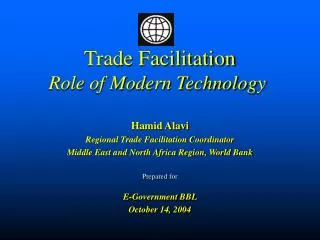
Trade Facilitation Role of Modern Technology
Trade Facilitation Role of Modern Technology Hamid Alavi Regional Trade Facilitation Coordinator Middle East and North Africa Region, World Bank Prepared for E-Government BBL October 14, 2004 Facilitating market access Quality standards and lowering technical barriers
902 views • 33 slides
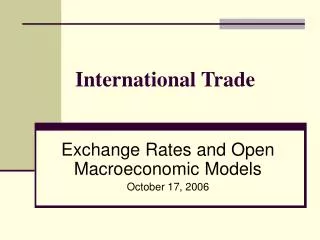
International Trade
International Trade Exchange Rates and Open Macroeconomic Models October 17, 2006 International trade is more complicated than domestic trade.
1.81k views • 95 slides
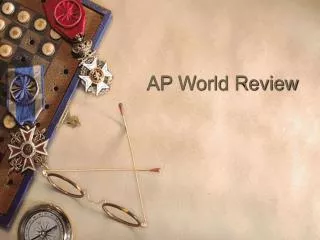
AP World Review
AP World Review. Six Themes. The impact of interaction among major societies, such as, trade, international exchange, war, and diplomacy. The relationship of change and continuity across the periods of World History.
1.53k views • 100 slides
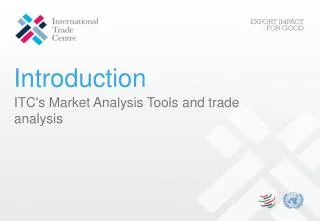
Introduction
Introduction. ITC's Market Analysis Tools and trade analysis. The UN body for design of policy recommendations to achieve economic and social development through trade and investment. The forum to negotiate multilateral trade rules, monitor their implementation and handle trade disputes.
1.08k views • 73 slides
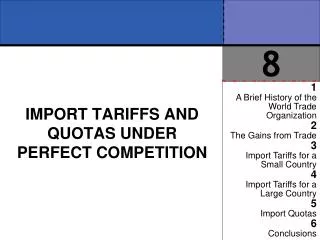
IMPORT TARIFFS AND QUOTAS UNDER PERFECT COMPETITION
8. 1 A Brief History of the World Trade Organization 2 The Gains from Trade 3 Import Tariffs for a Small Country 4 Import Tariffs for a Large Country 5 Import Quotas 6 Conclusions. IMPORT TARIFFS AND QUOTAS UNDER PERFECT COMPETITION. Introduction.
2.07k views • 66 slides
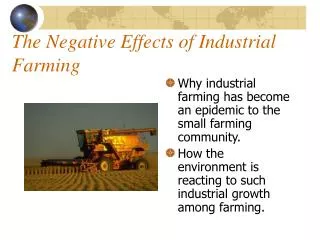
The Negative Effects of Industrial Farming
The Negative Effects of Industrial Farming. Why industrial farming has become an epidemic to the small farming community. How the environment is reacting to such industrial growth among farming. World Trade Organization. What is the WTO?
1.39k views • 14 slides
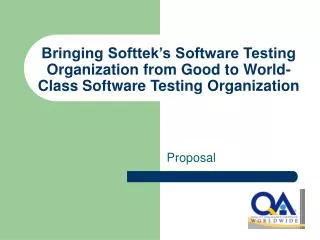
Bringing Softtek’s Software Testing Organization from Good to World- Class Software Testing Organization
Bringing Softtek’s Software Testing Organization from Good to World- Class Software Testing Organization. Proposal. Agenda. Mission Statement Vision Statement Goals Assessing Software Testing Capabilities – Your current processes
1k views • 55 slides

CHAPTER 19: International Trade
CHAPTER 19: International Trade. CHAPTER CHECKLIST. Describe patterns and trends in international trade. Explain why nations engage in international trade and why trade benefits all nations. Explain how trade barriers reduce international trade.
1.13k views • 66 slides
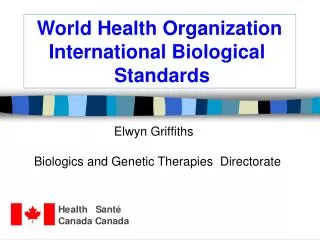
World Health Organization International Biological Standards
World Health Organization International Biological Standards. Elwyn Griffiths Biologics and Genetic Therapies Directorate. WHO’S BIOLOGICAL STANDARDIZATION PROGRAMME.
1.04k views • 62 slides
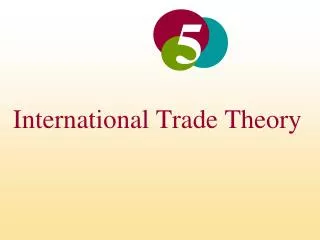
International Trade Theory
International Trade Theory. 5. INTRODUCTION theories that explain why it is beneficial for a country to engage in international trade are presented the pattern of international trade that is observed in the world economy are explained. International Trade Theory.
2.04k views • 39 slides
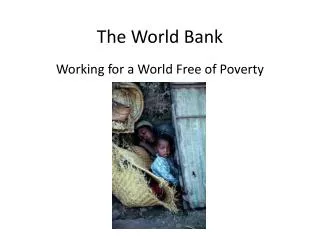
The World Bank
The World Bank. Working for a World Free of Poverty . Agenda. History What is poverty? World Bank’s role Structure of organization. How It All Began International Bank for Reconstruction and Development. Early Borrowers. 1950s: Physical. 1960s: Rural. 1970s: Human.
1.01k views • 83 slides

Quantitative Microbial Risk Assessment (QMRA) Salmonella spp. in broiler chicken
Suphachai Nuanualsuwan DVM, MPVM, PhD. Quantitative Microbial Risk Assessment (QMRA) Salmonella spp. in broiler chicken. Significance and Rationale. Public Health Bacterial foodborne disease Food safety Food for Export World trade organization (WTO) Trade barrier
1.4k views • 60 slides
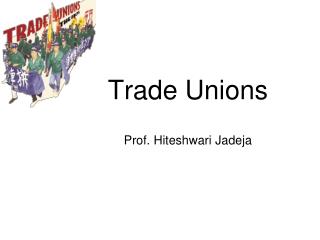
Trade Unions
Trade Unions. Prof. Hiteshwari Jadeja. Trade union: meaning. Trade union is a formal association of workers for the purpose of protecting and promoting their rights and interests through collective bargaining and actions. HISTORY OF TRADE UNION.
2.35k views • 43 slides
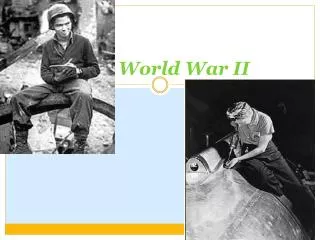
World War II
World War II. The Interwar Period 1919-1929. Independent Internationalism – increased trade, investment –thus involvement – but w/ Am. Interests and unilaterialism World order is too fragile to deal w/ crises of 30s w/o AM Twenties Pacifism Nye Committee Ludlow Amendment Diplomacy
972 views • 80 slides

International Trade Division
1. International Trade Division. Introduction to ITD Course Outline. 9. Mandate Organization ITD Sections Trade Concepts Data Flows & Processing Dissemination Balance of Payments Other Topics. Mandate:
856 views • 73 slides
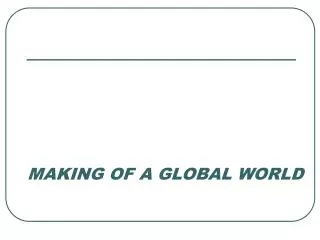
MAKING OF A GLOBAL WORLD
MAKING OF A GLOBAL WORLD. MAKING OF A GLOBEL WORLD. By globalization we mean increasing integration between different economies of the world. The making of the globel world has a long history of trade ,migration of people in search of work. Trade and culture exchange through the silk route.
9.13k views • 9 slides

International Trade
International Trade. Cheng Ming 程铭 School of Economics, Shanghai University chengming@shu.edu.cn. Introduction. Importance of foreign trade -- one of the backbones of the growth of the economy -- ties or linkages with the world -- important political means
2.4k views • 193 slides
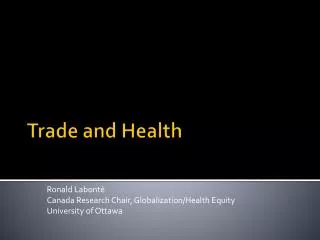
Trade and Health
Ronald Labonté Canada Research Chair, Globalization/Health Equity University of Ottawa. Trade and Health. To trade or not to trade?. That is not the question! Trade endemic to human societies, global trade as old as human settlements What changes is our notion of ‘global’ The questions:
1.38k views • 80 slides
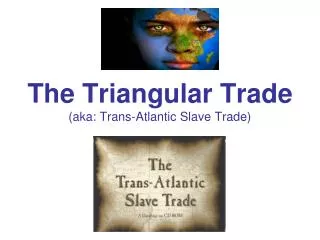
The Triangular Trade (aka: Trans-Atlantic Slave Trade)
The Triangular Trade (aka: Trans-Atlantic Slave Trade). DEFINITION. Triangular Trade : Trade routes between Africa, Europe and the Americas during the Atlantic Slave Trade. Spain, Portugal, & England.
1.29k views • 30 slides





















